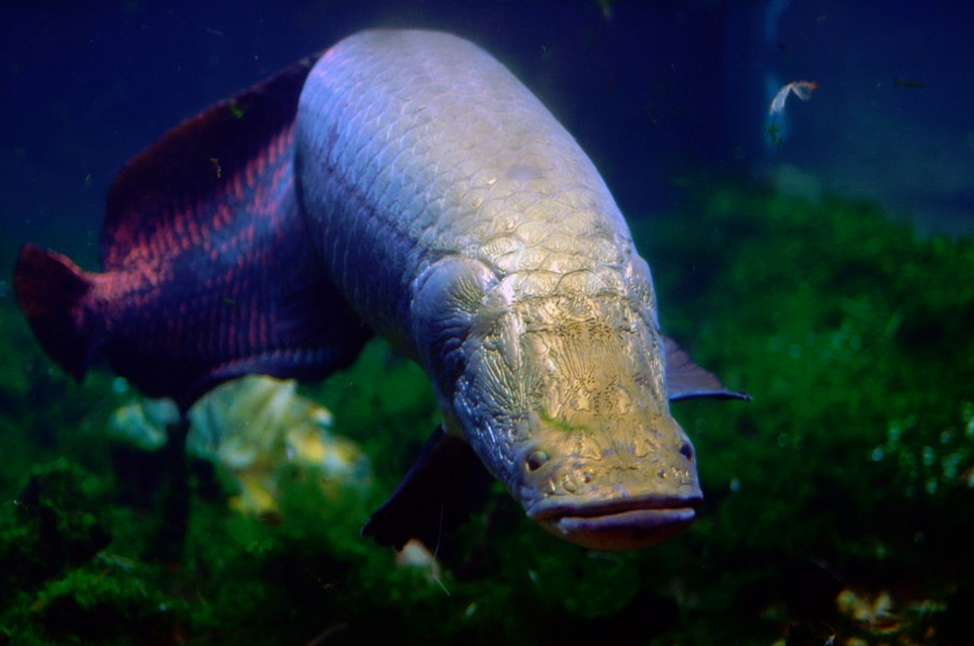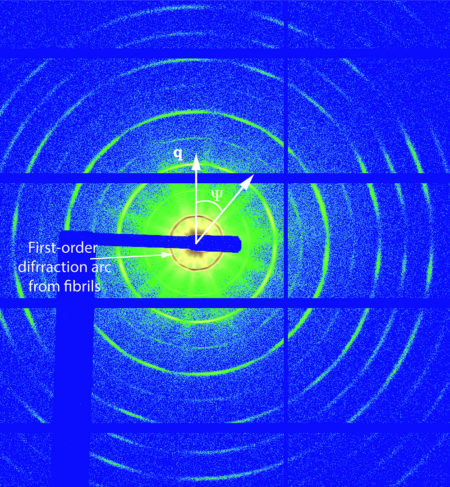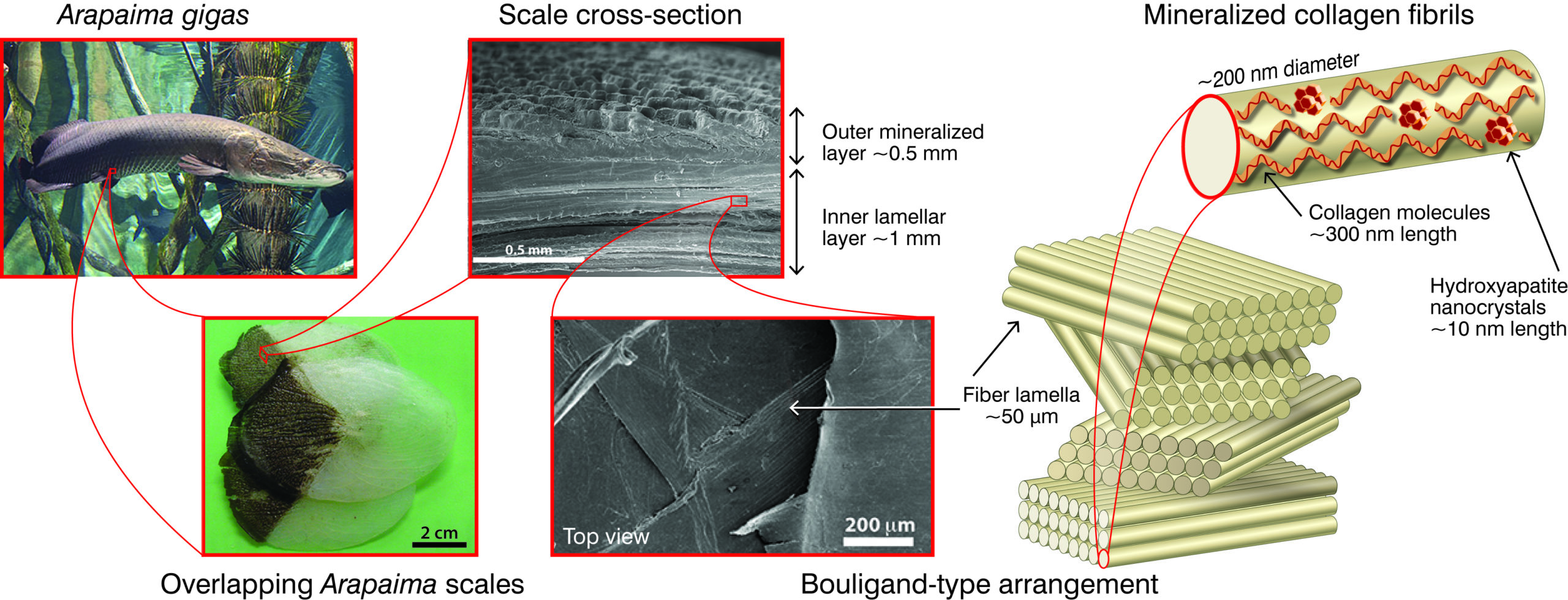Arapaima gigas, a freshwater fish found in the Amazon Basin, has a remarkable ability to resist predation by piranhas through the strength and toughness of their scales, which act as natural dermal armor. Arapaima scales consist of a hard, mineralized outer shell surrounding a more ductile core. This core region is composed of aligned mineralized collagen fibrils arranged in a fine, plate-like structure. To study how these scales respond to applied stresses at the molecular level, researchers used the small-angle x-ray scattering (SAXS) facilities at ALS Beamline 7.3.3. Mechanical tensile tests allowed researchers to observe deformation mechanisms in the fibrils and see how the arrangement of the fibrils plays a key role in the scales’ unique protective properties.

Remarkably, most lamellae reorient towards the tensile axis and deform in tension through stretching/sliding mechanisms, whereas other lamellae sympathetically rotate away from the tensile axis and compress, thereby enhancing the scale’s ductility and toughness to prevent fracture.
Under in situ tensile loading at the beamline, researchers found that most of the lamellae rotate towards the direction of the applied stresses to better resist the applied loads. The novel assembly of mineralized collagen fibrils in Arapaima’s special “armored” scales is the first line of defense.
During mechanical tensile tests at the ALS, researchers found that the scales can literally re-orient themselves in real time to resist force, in essence creating an adaptable body armor. SAXS imaging revealed that that the collagen fiber in the fish scale core are arranged in what researcher Robert Ritchie of Berkeley Lab’s Materials Sciences Division describes as a “Liberace-type spiral staircase.” When subjected to stress, the lamellae in this spiral staircase re-orient themselves to accommodate excess deformation and resist fracturing.
Most hard biological materials, such as bone, antler, and teeth, derive their structural integrity from their hierarchical architecture. Such hierarchical assembly allows a damage-tolerant material to be created from the basic building blocks of ductile, but soft, collagen molecules and stiff, but brittle, mineral nanocrystals: strength comes primarily from the ability to absorb energy at small length-scales through composite deformation of the mineral and protein phases, whereas toughness primarily originates from larger length-scales that are able to influence crack growth.

The protective scales of the Arapaima fish are a prime example of a biological material’s evolution for a particular function. The scales specifically resist the bite of piranhas through multiple levels of defense provided by the scale’s hierarchical architecture.
First, the scales’ aspect ratio (that is, length/thickness) and degree of imbrication (that is, exposed length/total length) both not only provide flexibility during movement but also determine how much an individual scale will bend in response to a predatorial attack.
Second, scales commonly have graded material properties throughout their thickness to resist both puncture and bending. For Arapaima gigas scales, there are two distinct macro-level regions: a hard, highly mineralized outer shell and a collagen inner core region. The highly mineralized outer shell provides hardness to minimize local plasticity and promote tooth fracture at the point of penetration by the predator; however, it also reduces tensile or compressive stresses during flexure through its corrugated morphology, which limits how much of the scale is under high stress during bending. As the scales will deform and bend in response to a predatory attack, the graded material properties through the scale thickness ensure that the larger deformations are in the inner core region, which can support greater amounts of plastic deformation than the hard but more brittle outer shell.
Arapaima’s fish-scale armor could inform the design of other types of armor. Ritchie believes that the unique mechanism of conferring toughness could be mimicked and built into synthetic structural materials to yield enhanced damage tolerance. For example, heavy Kevlar armor used by the U.S. military and police officers could be replaced with armor that would be every bit as effective but much lighter in weight.

Contact: Robert O. Ritchie
Research conducted by: E.A. Zimmermann (Lawrence Berkeley Lab), B. Gludovatz (Lawrence Berkeley Lab), E. Schaible (Lawrence Berkeley Lab), N.K.N. Dave (Lawrence Berkeley Lab), W. Yang (UC San Diego), M.A. Meyers (UC San Diego), and R.O. Ritchie (Lawrence Berkeley Lab).
Research funding: U.S. Department of Energy (DOE), Office of Basic Energy Sciences (BES). Operation of the ALS is supported by DOE BES.
Publication about this research: E.A. Zimmermann, B. Gludovatz, E. Schaible, N.K.N. Dave, W. Yang, M.A. Meyers, and R.O. Ritchie “Mechanical adaptability of the Bouligand-type structure in natural dermal armour,” Nature Communications 10, 1038 (2013), doi:10.1038/ncomms3634.
ALS SCIENCE HIGHLIGHT #281